The shop of the website for8Bits is Open
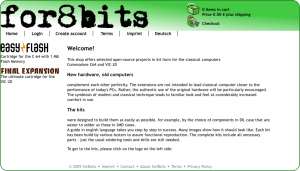 This shop offers selected open-source projects in kit form for the classical computers
This shop offers selected open-source projects in kit form for the classical computers
Commodore C64 and VIC-20.
Like:
- C-64 EasyFlash.
- VIC-20 Final Expansion.
source: for8bits.com
 This shop offers selected open-source projects in kit form for the classical computers
This shop offers selected open-source projects in kit form for the classical computers
Commodore C64 and VIC-20.
Like:
source: for8bits.com
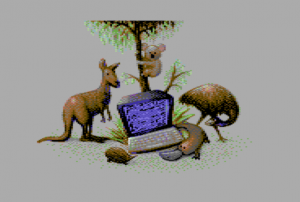 Onslaught / Wrath Designs / Vandalism new stuff, bring you the 52th Vandalism News, released at the Syntax DemoParty 2009.
Onslaught / Wrath Designs / Vandalism new stuff, bring you the 52th Vandalism News, released at the Syntax DemoParty 2009.
source: syntaxparty.com noname.c64.org
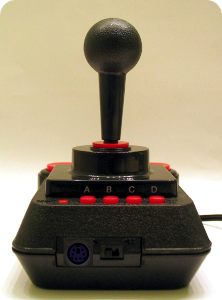 Keyboard Twister by Shadowolf is an ATtiny45-based hardware solution to fix some issues in the DTV’s keyboard emulation.
Keyboard Twister by Shadowolf is an ATtiny45-based hardware solution to fix some issues in the DTV’s keyboard emulation.
A user “abraXxl” on forum64.de has introduced some fix and enhancement of this cool project.
source: forum64.de (only German language)
![]() Click here to jump to the M2i c64 games website. The file estension M2i is used by the SD2Iec interface.
Click here to jump to the M2i c64 games website. The file estension M2i is used by the SD2Iec interface.
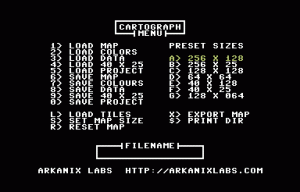 Cartograph is a native Commodore 64 application created for designing tile-based maps/levels.
Cartograph is a native Commodore 64 application created for designing tile-based maps/levels.
This versatile tool allows you to create maps and levels for your games, matrices and data for demos and tools and much more.
Changelog:
source: c64.sk arkanixlab.com
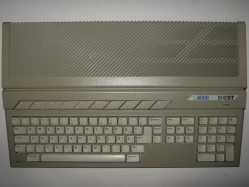
Autopsy:
from Wikipedia:
The Atari ST is a home/personal computer that was commercially available from 1985 to the early 1990s. It was released by Atari Corporation in 1985. The “ST” officially stands for “Sixteen/Thirty-two”, which referred to the Motorola 68000′s 16-bit external bus and 32-bit internals.
The Atari ST was part of the 16/32 bit generation of home computers, based on the Motorola 68000 CPU, with 512 KB of RAM or more, and 3½” single density double sided floppy disks as storage (nominally 720KB). It was similar to other contemporary machines which used the Motorola 68000, the Apple Macintosh and the Commodore Amiga. Although the Macintosh was the first widely available computer with a graphical user interface (GUI), it was limited to a monochromatic display on a smaller built-in monitor.
Preceding the Amiga’s commercial release by almost two months, the Atari ST was the first computer to come with a fully bit-mapped color GUI, using a version of Digital Research’s GEM released that February. It was also the first home computer with integrated MIDI support.
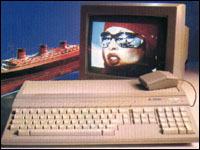 The ST was primarily a competitor to the Apple Macintosh and the Commodore Amiga systems. This platform rivalry was often reflected by the owners and was most prominent in the Demo Scene. Where the Amiga had custom processors which gave it the edge in the games and video market, the ST was generally cheaper, had a slightly faster CPU, and had a high-resolution monochrome display mode, ideal for business and CAD.
The ST was primarily a competitor to the Apple Macintosh and the Commodore Amiga systems. This platform rivalry was often reflected by the owners and was most prominent in the Demo Scene. Where the Amiga had custom processors which gave it the edge in the games and video market, the ST was generally cheaper, had a slightly faster CPU, and had a high-resolution monochrome display mode, ideal for business and CAD.
Thanks to its built-in MIDI ports it enjoyed success as a music sequencer and controller of musical instruments among amateurs and professionals alike, being used in concert by bands such as Tangerine Dream, Fatboy Slim and 90s UK dance act 808 State. In some markets, particularly Germany, the machine gained a strong foothold as a small business machine for CAD and Desktop publishing work.
The ST was later superseded by the Atari TT and Falcon computers. Since Atari pulled out of the computer market there has been a market for powerful TOS-based machines (clones). Like most “retro” computers the Atari enjoys support in the emulator scene.
source: wikipedia atari-forum
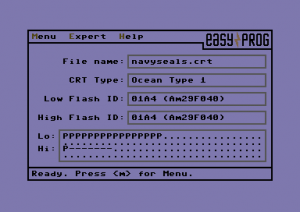 EasyProg is a program for the C64. It is used to write (“burn”) cartridge image files (*.crt) onto an EasyFlash.
EasyProg is a program for the C64. It is used to write (“burn”) cartridge image files (*.crt) onto an EasyFlash.
Changes:
source: easyflash homepage
Sorry, this entry is only available in Italian.
 The Movie and Pictures of retro game show Van Pong tot Playstation 2009 are online on site commodore-gg.hobby.nl.
The Movie and Pictures of retro game show Van Pong tot Playstation 2009 are online on site commodore-gg.hobby.nl.
source: commodore-gg.hobby.nl
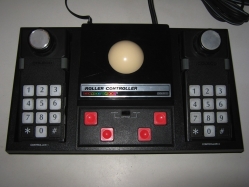
Autopsy:
from Wikipedia:
Coleco prototyped a fourth expansion module intended to provide compatibility with Mattel’s Intellivision, but this was never released.
Two controller expansions were also available. First was the Roller Controller, a trackball packaged with a port of the arcade game Slither, a Centipede clone and meant to be used with some dedicated games like Victory or to enhance the gameplay of previously published cartridges which benefitted from its trackball system (like Wargames).
The second was the Super Action Controller Set, resembling a pair of boxing gloves each with joystick and numeric keypad on top and a series of buttons along the grip. It came with the game Super Action Baseball and saw later release of the Rocky Super Action Boxing, and a port of Front Line.
source: wikipedia

Autopsy:
from Vintagecomputing:
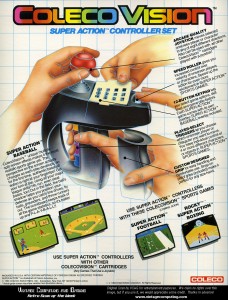 And you thought video game controllers were over-complicated these days; this one requires five (slightly-pudgy child) hands just to use it properly.
And you thought video game controllers were over-complicated these days; this one requires five (slightly-pudgy child) hands just to use it properly.
Take a look at this bad boy: four trigger buttons on the pistol-like grip (one per finger), twelve buttons in the overlay-friendly numeric keypad matrix on top, a one-dimensional “speed roller” wheel near the back, and an extremely flaccid red-knobbed joystick crowning it all.
Combine this with the futuristic look of a gaudy black space gauntlet that literally engulfs your hand, and you’ve got the ColecoVision Super Action Controller.
This marvel of controlling technology came in sets of two with a “Super Action Game” included — Super Action Baseball or Rocky Super Action Boxing.
source: vintagecomputing.com
Recent Comments